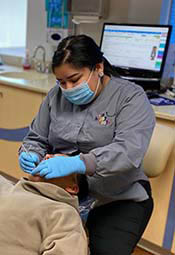Your smile is the first thing people tend to notice about you. It shows strangers and friends alike that you are welcoming and ready to greet the world with enthusiasm. But if you have crooked teeth or other dental issues, showing your smile can make you want to disappear. The good news is that adult braces can help at any age and are the best way for you to quickly improve your smile. And MyOrthodontist, in Chapel Hill, NC, is the best place to give yourself the gift of a beautiful and confident smile.
Am I Too Old for Braces?
No matter your age, you are never too old for braces, and it’s never too late to give yourself the smile you’ve always wanted. There’s no age limit on having a healthy smile! The forces that turn crooked teeth into a perfect smile in a teenager work the same way for adults, no matter how old. Plus, adults tend to follow their orthodontist’s instructions far better than teenagers, meaning that their treatment time is often shorter and more effective.
Adult Braces Can Help at Any Age
While braces are the best way to get yourself the perfect smile, braces aren’t purely cosmetic and can improve your life far beyond appearance. Straight teeth are easier to clean than crooked ones and tend to result in far better oral hygiene, which then leads to a reduction in your chances of developing gum disease or tooth decay.
Furthermore, improving the function of your teeth and jaws through orthodontic treatment can have a whole host of benefits. It can help improve the function of everything your mouth does, including breathing, speaking, and chewing. It can also reduce the abnormal wear of certain teeth, helping your teeth retain their health as you age. Braces also help to balance the forces of your bite, which can help to alleviate headaches, pain, and TMJ. As you grow older, issues stemming from your bite tend to grow more severe; investing in braces for adults can help you age with grace and without unnecessary pain.
How Do Braces Work?
TYPES OF BRACES
At MyOrthodontist, we offer two types of braces to help fit your unique needs.
METAL BRACES
These traditional braces are the most common type of braces, where all the components of the braces are made of metal. You might remember traditional metal braces from when you were a teen, but technological advances have made them much smaller and far less noticeable than they have been in past decades.
CERAMIC BRACES
Ceramic braces are a great alternative to traditional metal braces. They work the same way and have all the same components, but rather than being made of metal, they are made of ceramic. This allows your braces to blend easily into your teeth, so they are far less noticeable. Ceramic braces are a great option for adults who want the benefits of braces but don’t want to deal with the look of metal braces.
In the early days of their existence, ceramic braces were easily stained by food. This, however, is no longer the case thanks to improvements in the ceramics. These are the best way to effectively correct your teeth inconspicuously.
Components of Braces
Whether you choose to get traditional metal braces or ceramic ones, they will have the same basic components. No matter what your braces are made of, they work the same way.
BANDS
Orthodontic bands are circular rings that fit around your backmost molars and act as an anchor for the whole line of braces. Bands come in different sizes to accommodate whatever size teeth you have, and dental instruments are used to give you a custom fit. The bands have attachments welded into the side to allow for the archwire to connect and be anchored into them.
BRACKETS
Brackets are small, square-shaped pieces that are attached to every tooth being treated. Depending on what your treatment looks like, your orthodontist may choose to affix a bracket to every tooth, or just a couple. Brackets have a slot in them for the archwire to pass through.
ARCHWIRE
Archwires are crescent-shaped pieces of wire that fit into each of the brackets and anchor into the bands on the back molars. Archwires work to exert force on each of the teeth being treated and are responsible for the continuous repositioning of your teeth. Each time you visit your orthodontist, they will remove your archwire and either bend it again or replace it with a new wire that is heavier and can exert greater force.
RUBBER LIGATURES
After the archwire is placed, ligatures are tied around each bracket to attach the wire to the brackets and keep your braces together. Whenever your archwire is removed, the rubber ligatures will be removed first, and replaced with new ones.
REMODELING YOUR SMILE
No matter your age, the way braces work to perfect your smile is exactly the same. While it seems like braces are simply moving your teeth within your gums, it’s actually a bit more complicated. It’s a biomechanical response called remodeling that occurs as a result of the pressure of the braces on the periodontal membrane, which surrounds the root of your tooth, and the alveolar bone to which it is attached.
POSITIVE AND NEGATIVE PRESSURE
It might seem like using a strong force would help your teeth remodel quicker, but they actually respond better to braces that provide a light and constant force. This causes one side of the tooth to press against the periodontal membrane, creating positive pressure. At the same time, the opposite side of the tooth is pulled away from the periodontal membrane, creating negative pressure and resulting in a space between the tooth and the membrane.
Two biological functions occur as a reaction to the positive and negative pressure: deposition and resorption. On the side of the tooth that is being pushed against the periodontal membrane, osteoclasts are produced. Osteoclasts are bone-destroying cells and break down the bone as a result of positive pressure. This process is called resorption.
On the other side, where the tooth is being pulled away from the periodontal membrane, osteoblasts are produced. Osteoblasts are bone-growing cells that are created in response to the negative pressure. Resorption happens pretty quickly, in only a couple of days. Deposition, however, is slower and can take about three months. As your teeth break down and then regrow, they appear to be moving within your gums, into the correct positions.
How Do I Get Adult Braces?
Once you’re ready for a healthy and confident smile, schedule a consultation with MyOrthodontist. We even offer a complimentary new patient consultation to help you on your way.
CONSULTATION
At your complimentary consultation, you’ll meet your orthodontist and get comfortable with the team here at MyOrthodontist. Your orthodontist will look at your teeth to see what needs to be done to give you the perfect smile. If you’ve had x-rays taken recently, you should bring them along to give your orthodontist a better idea of what is going on beneath the surface.
DESIGNING TREATMENT
After your complimentary consultation, your orthodontist will work on designing a treatment specific to your orthodontic needs. Braces are not a one-size-fits-all experience, and your braces need to be placed in a specific way in order to address your unique needs. Your orthodontist might create a mock-up of your braces on a mold of your teeth to show you what your treatment will look like.
PLACING THE BRACES
At your initial appointment after your consultation with your orthodontist, you will get your braces. You can expect this appointment to take longer than the typical follow-up appointments. Your orthodontist will start by conditioning the surface of your teeth and priming them so they are ready for the special dental cement that is used during the process.
Once the teeth are ready, your orthodontist will use the dental cement to attach the brackets to your teeth in predetermined positions. They will also use the cement, along with other tools, to create a custom fit for your bands on your back molars.
After the brackets and bands have been placed, your orthodontist will insert the wire into the brackets. They start with a semicircle of wire and cut it to the right length, then bend it to fit your mouth and bite. They may make specific kinks into the wire in order to create leverage over certain teeth that might need extra help moving into the correct position. Once the wire is placed, your orthodontist will wrap rubber ligaments around the brackets to hold everything in place.
DISCUSSION OF ORAL CARE
Once your orthodontist is finished placing your braces, they will go over the basics of caring for your braces. They’ll give you directions on how to effectively and safely brush your teeth to keep your oral hygiene up.
They’ll also give you advice on foods to stay away from while you have braces. Lots of foods can break your archwire or pop a bracket off of your tooth. Generally, you should stay away from sticky, crunchy, and hard foods. Stay away from foods that you have to take a bite out of, or that will be difficult to remove from your braces. Popcorn and candy are some of the most dangerous foods for adults with braces.
ADJUSTMENTS
After your braces are placed and you are on your way to a healthy smile, you will have to come back in for appointments every month or so. These appointments are called adjustments because your orthodontist will adjust your braces to encourage continued movement. They will remove the rubber bands from around the brackets, and then remove the archwire.
They might bend the archwire again to put more pressure on your teeth or replace it with a new wire altogether. At each adjustment, your orthodontist will assess the movement of your teeth, and make changes to your archwire to get each of your teeth to wherever they need to go.
DENTIST APPOINTMENTS
Going in for regular dentist appointments to clean your teeth is always important, but it’s especially so when you have braces. Cleaning your braces can be difficult when brackets and wires get in the way, and the dentist can help you keep your teeth clean.
Contact Us to Learn More
It’s never too late to give yourself the perfect smile. Adult braces are the best way to not just improve your confidence, but your oral health as well. If you’ve always wanted to fix your crooked teeth or unhealthy bite, braces are the answer.
To schedule your complimentary consultation for adult braces today, call MyOrthodontist, in Chapel Hill, NC.


